Utkatasana is a very powerful posture in Yoga, which engages each and every part of the body. It is also one of the postures in Ashtanga Surya Namaskar (A & B both) and is starting position for many other postures in Yoga.
The posture looks very easy to master but it requires a great amount of strength in the legs, hips, core muscles, back and concentration to maintain equilibrium to perform the posture correctly.
It is a very good example wherein the body is expanding in two different directions i.e. feet put firmly on the ground with hand expanded upwards and yet trying to maintain an equilibrium in the position.
Mythology and Origins
The word Utkatasana consists of two Sanskrit words, Utkata and Asana. Takata means immense, violent, fierce, powerful, and proud and Asana means “posture”. It is also called a chair pose because the posture looks as if a Yogi is sitting on an imaginary chair.
The words proud, and immense do not seem to be related to Chair and appear to be different but still are related to single asana. You must be wondering about the link between the two.
One of the explanations can be that in ancient times, chairs or thrones were used by powerful and fierce people or people who were in authority and privileged one, hence, Utkatasana is linked with the Chair pose.
It is also said that the asana has its origin in Hindu mythology from Ramayana where Lord Ram struggled for fourteen years with his wife Sita and brother Lakshman, travelling across India and then returning back to his birthplace to assume the throne and be crowned as king of Ayodhya. This myth is concerned with the theme of Utkata: power, courage, and ferocity, all embodied by Rama.
It is also called Fierce Pose, Powerful Pose or Awkward Pose.
Yoga Scripture
As per 17th century Gheranda Samhita, Utkatasana is one of the important 32 postures out of eighty-four lakh postures taught by Siva. As per verse 27 of Chapter 2, Utkatasana is “Firmly putting toes on the ground and lifting the heels in the air, and placing the anus on the heels.“
However, as per modern yoga, the posture is not done in the way explained above.
Benefits of Utkatasana
The posture has a lot of physical and spiritual benefits. Some of the major benefits are as follows:
Physical Benefits
- It strengthens the legs including calves, hamstrings, and hips and helps in reducing fat from the thighs and hips as the body is in a deep squat position in this posture.
- It also strengthens the knees and the ankles.
- It lengthens the spine and lower back and provides relief for back pains.
- It tightens the core muscles as a lot of core strength is used while holding the posture and maintaining equilibrium. It strengthens the entire digestive system.
- It stretches the entire upper body including the shoulder, arms and neck and helps to open up the upper body.
- It also helps in the expansion of the chest and stimulates the diaphragm, which in turn improves our breathing capacity. Deep breathing is done while holding in this posture resulting in strengthing the entire respiratory system.
- Further, deep breathing reduces stress and helps in strengthening the immune system.
- It improves our immune system and cardiovascular systems.
- It helps to maintain equilibrium in the body.
Spiritual Benefits
- It helps in the improvement of focus, concentration and memory
- It relaxes our minds and reduces the stress level
- It helps to increase the awareness towards the body
- It also helps to activate the Manipur Chakra, Muladhara Chakra,
Preparatory Poses
Some of the preparatory poses are as follows:
- Suryanamaskar
- Bhujangasana/ Urdhva Mukha Svanasana (Upward facing Dog)
- Virasana
- Adho Mukha Svanasana (Downward Facing Dog)
Who should not do Utkatasana?
- People who have knee problems, ankle pains, suffering from arthritis, and back injuries should avoid doing it
- Do not practice this posture if you are suffering from a headache.
- Perform gently or avoid practising the posture during menstruation
- Pregnant women should avoid doing it
- The posture should not be performed after having meals
- Beginners should do it only under the supervision of a Yoga expert.
Steps to Perform Utkatasana
The steps to perform Utkatasana are as follows:
- Stand in Samastithi position. Place your feet together. In the case of beginners, shoulder width distance can be maintained to maintain balance.
- Inhale and raise your hands upwards. The hands should be placed alongside the ears.
- Arms should be kept straight and palms must be facing each other. You can also join your palms.
- Roll down your shoulders and keep your neck elongated. Push your shoulder blade down and backwards.
- The chest should be open and your core muscles should be kept tight and engaged. This will help you to maintain your posture.
- Now, gaze upwards towards your pointed hands or beyond that towards the ceiling
- Exhale and bend your knees in such a way that your thighs are perpendicular to the ground. It would feel as if you are sitting on a chair
- Make sure that the pressure is on the thighs and hips and that no pressure is there on the knees.
- Further, your knees should not come forward more than your big toes. That means when you look down you are able to see your big toes otherwise it will create a lot of pressure on your knees
- The spine should be elongated and the back should be kept straight.
- Try not to lean forward or backwards and maintain a position of equilibrium with feet put firmly on the ground and hands expanding upwards.
- Stay in the position for some time (can start with 30 seconds) and breathe deeply and slowly. Try to maintain a connection between the body and the breath
- To come back to the original position, Inhale and straighten your knees and exhale bringing your hands down.
- To make it more challenging you can keep a chair and while bending try your buttock to touch the edge of the chair, that way you will ensure that the thigh stays parallel to the ground.
- Further, you can hold blocks in your hands to ensure that your core is engaged actively and core strength is used.
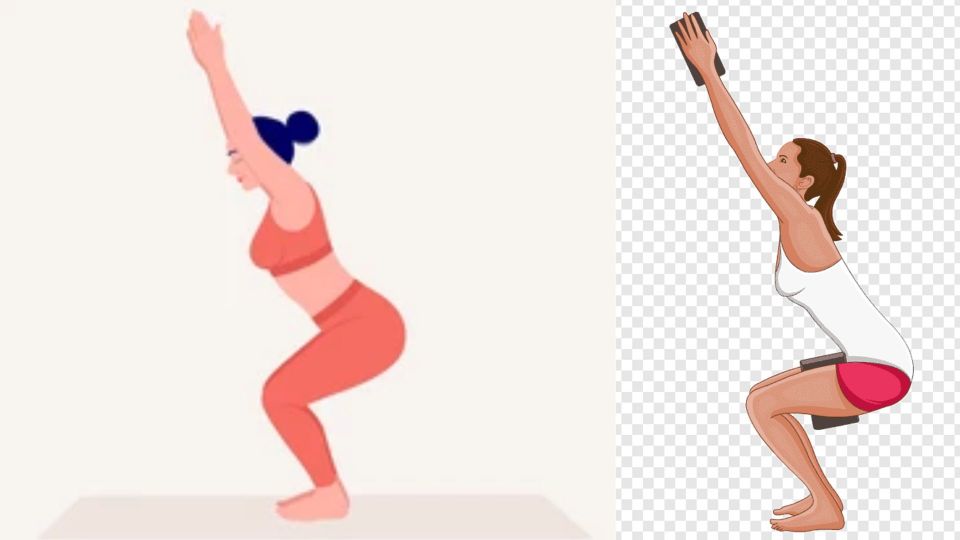
Counter Poses
- Uttanasana
- Cat & Cow pose
- Balasana
Tips/ Precautions for Beginners
- It’s challenging to perform the pose with both feet together. Beginners can maintain shoulder width distance for ease of posture
- Your knees should not go past your toes otherwise it may put pressure on your knees.
- Do not lift your heels in the posture. Keep your heels down.
- Keep your shoulders down; do not push them upwards towards your ears.
- Do not arch your back forward, try to keep it straight otherwise it may impact the back muscles.
- In starting, practice can be done with the help of a wall so as to reduce pressure on the knees and back and later it can be practised without a wall.
- Further, the block can be kept between the thighs and pushing it tight so as to avoid knees going outwards at the beginning which will help in understanding the posture.
- Do not force yourself to keep your thighs parallel to the floor; you can also keep it at 120 degrees in starting.
- Perform this asana in the presence of a Yoga expert in the beginning.
Variations of Utkatasana
Parivritta Utkatasana (Chair Twist Pose)
In the Utkatasana position, half bend forward and then twist your body towards the right side and put your left elbow on your right knee and maintain the Namaste position.
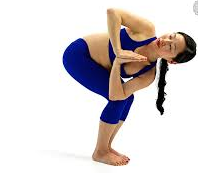
Utkata Konasana (Goddess Pose)
Maintain three feet distance between feet and turn your knees and toes out. Then bend your knees with thighs parallel to the floor. Make a Namaste with both hands.
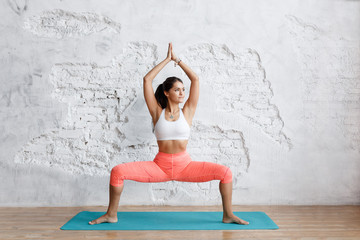
Ek Pada Utkatasana (One-Legged Chair Pose)
In Utkatasana, bring your hands in Namaste position in front of your chest and put one leg on the thigh of another leg.
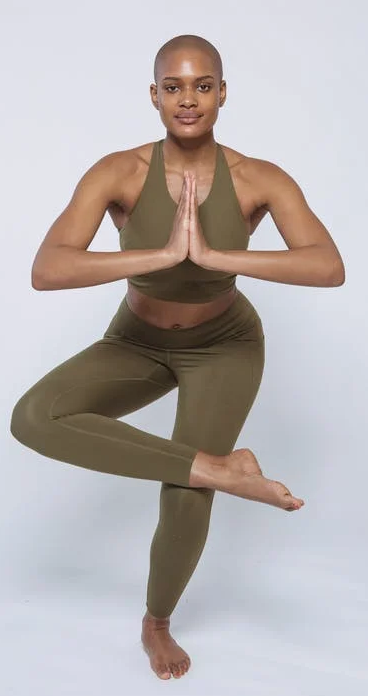
Caution
This asana should be performed in the presence of a Yoga expert to avoid injuries. Do remember that everybody is different and impact of asana on everybody is different.
HAPPY DOING YOGA!!
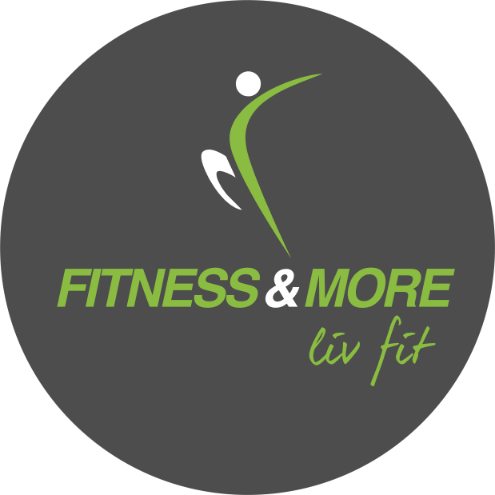
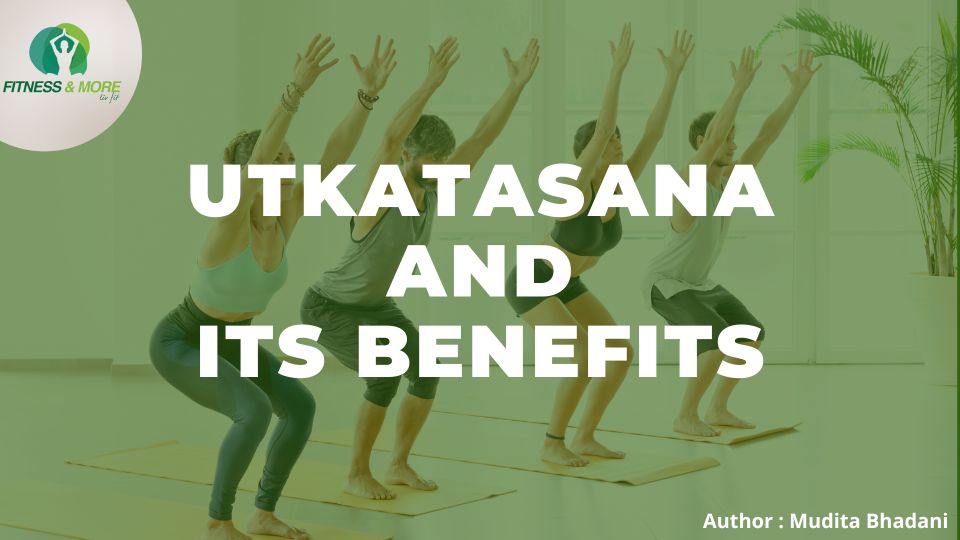
Recent Comments